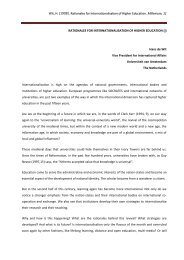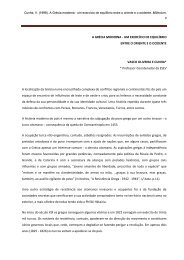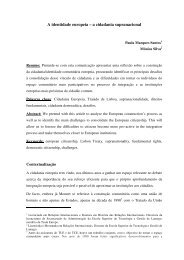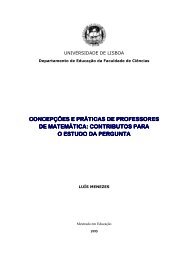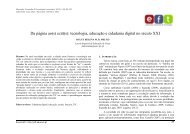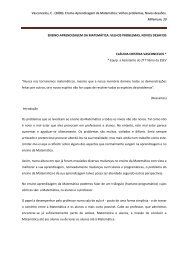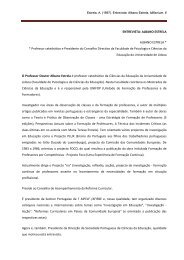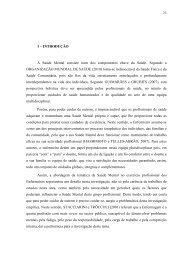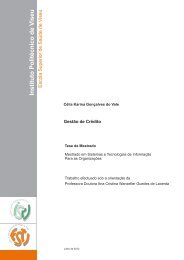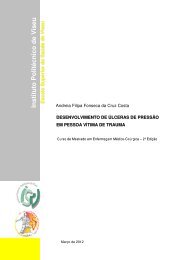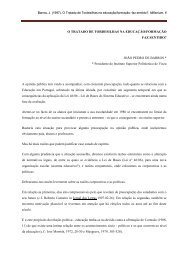Amino acid profile and Maillard compounds of sun-dried pears ...
Amino acid profile and Maillard compounds of sun-dried pears ...
Amino acid profile and Maillard compounds of sun-dried pears ...
Create successful ePaper yourself
Turn your PDF publications into a flip-book with our unique Google optimized e-Paper software.
Eur Food Res Technol (2011) 233:637–646 639at the village <strong>of</strong> Ervedal da Beira (Oliveira do Hospital,Portugal) at the commercial maturity stage (Fig. 1a). Onaverage, the fresh fruits had a mass <strong>of</strong> 64 g, with a diameter<strong>of</strong> 4.3 cm <strong>and</strong> height <strong>of</strong> 6.5 cm. The moisture content was78%.For fresh pear analysis, some fruits were frozen justafter harvesting. The remaining fruits were processedaccording to the different methodologies under study.According to the traditional <strong>sun</strong>-drying process, thefresh fruits were peeled <strong>and</strong> allowed to dry in an openspace with <strong>sun</strong>shine incidence, as described by Ferreiraet al. [5] (Fig. 1b). After being peeled, fresh <strong>pears</strong> werealso allowed to dry in two greenhouses that differed in theirsize, structure <strong>and</strong> location. GH1 was provided with airconvection, with a flux <strong>of</strong> 900 m 3 h -1 , it was located atground level <strong>and</strong>, in comparison to GH2, had the largestcargo capacity. Its area was 6.3 m 2 (3.19 m long by 1.93 mwide), <strong>and</strong> the height in the sides was 1.24 m, whereas inthe middle was 1.97 m. The structure was aluminium withhorticulture glass <strong>and</strong> there were two ro<strong>of</strong> windows for airextraction. The drying time for GH1 was approximately7 days (Fig. 1c). The GH2 greenhouse consisted <strong>of</strong> insulatedglass panels <strong>and</strong> had the form <strong>of</strong> a box (1.20 m heightby 1.20 m long <strong>and</strong> 1.00 m wide). Inside, it was composedby a U-shaped structure, parallel to the floor, where <strong>pears</strong>were let to dry. GH2 was located on a ro<strong>of</strong> <strong>of</strong> a building<strong>and</strong> contained a step structure coated with reflective film,where <strong>pears</strong> were allowed to dry. This interior structureallowed a greater incidence <strong>of</strong> the light <strong>and</strong> consequentlypromoted the drying process by natural air convection, withthe air entering in the lower level (first step) <strong>and</strong> leaving inthe higher level, by means <strong>of</strong> a gir<strong>and</strong>ole. The drying timefor GH2 was approximately 5 days (Fig. 1d), 2 days lessthat the drying time <strong>of</strong> GH1.For hot air tunnel drying (HAT), after peeled, <strong>pears</strong> werelet to dry at a constant temperature <strong>of</strong> 40 °C <strong>and</strong> an air flow<strong>of</strong> 1.2 m s -1 for about 7 days (Fig. 1e). The drying tunnelwas 2 m long, <strong>and</strong> the air convection was promoted by aventilator placed at the entrance <strong>of</strong> the tunnel. In thisstructure, <strong>pears</strong> were not exposed to light, although the airwas heated by a solar collector, <strong>and</strong> therefore the <strong>sun</strong> wasalso the main source <strong>of</strong> energy.Independently <strong>of</strong> the type <strong>of</strong> processing used, the processedfruits reached a mass <strong>of</strong> 10–14 g with a moisturecontent <strong>of</strong> 20% <strong>and</strong> had a maximum width <strong>of</strong> 2.5–3.4 cm,height <strong>of</strong> 3.9–4.7 cm <strong>and</strong> thickness <strong>of</strong> 1.2–1.5 cm. Thesensory descriptive <strong>pr<strong>of</strong>ile</strong> <strong>of</strong> the traditional product, whenevaluated by a sensory panel test, is the following: brown–red uniform colour (Fig. 1b), sweet <strong>and</strong> slight <strong>acid</strong>, with anot too hard–not too s<strong>of</strong>t texture <strong>and</strong> presenting elasticity.Concerning GH1, it was considered very similar to thetraditional product, with the same rate <strong>of</strong> global appreciation,but with lower colour uniformity (Fig. 1c), sweetness<strong>and</strong> elasticity. GH2 was similar to GH1, although obtaininga lower global appreciation, possibly due to an even lower<strong>acid</strong>ity (Fig. 1d). HAT presented the sensory <strong>pr<strong>of</strong>ile</strong> closeto the traditional product concerning colour uniformity,sweetness <strong>and</strong> toughness but it was not appreciated due tothe colour tonality (yellow-orange) (Fig. 1e) <strong>and</strong> slight less<strong>acid</strong>ity. This product, although having the accurate organolepticcharacteristics except the colour, was rejected bythe panellists due to the inaccurate colour when comparedwith the traditional product.Before analysis, the pulp <strong>of</strong> the fresh <strong>and</strong> <strong>dried</strong> <strong>pears</strong>was collected, ground <strong>and</strong> freeze-<strong>dried</strong>.<strong>Amino</strong> <strong>acid</strong>s analysisThe methodology for <strong>acid</strong> hydrolysis <strong>of</strong> protein materialwas adapted from Zumwalt et al. [22]. To a test tube with ascrew cap with PTFE coating was rigorously weighed10 mg <strong>of</strong> freeze-<strong>dried</strong> material. To each sample, 2 mLhydrochloric <strong>acid</strong> (HCl) 6 M was added; the content <strong>of</strong> thetubes was frozen in liquid nitrogen, evacuated during 1 minwith a vacuum pump <strong>and</strong> refilled with nitrogen. Afterthawing, the suspension was sonicated for 5 min in anultrasound bath at room temperature. The procedure <strong>of</strong>freezing–vacuum–sonication was repeated twice. Thehydrolysis took place during 24 h at 110 °C using a heatingblock. After cooling to room temperature, 500 lL <strong>of</strong> theFig. 1 The S. Bartolomeu pear.a Fresh <strong>pears</strong> <strong>and</strong> <strong>pears</strong> <strong>dried</strong> bydifferent technologies:b Traditional, c GH1, d GH2<strong>and</strong> e HAT123




